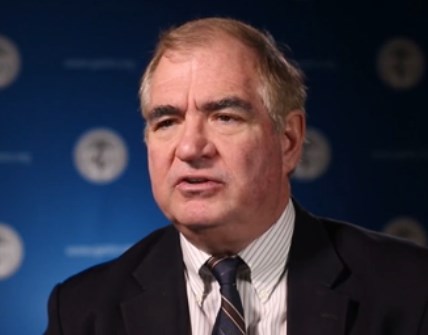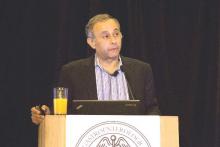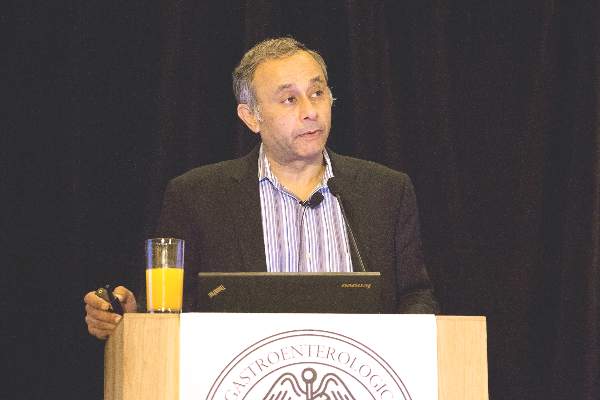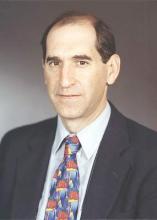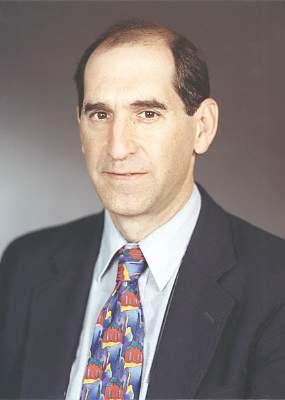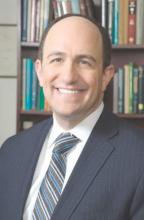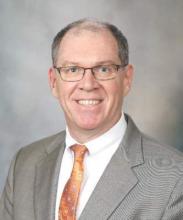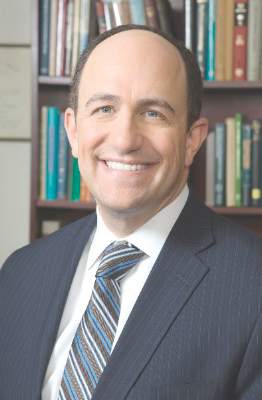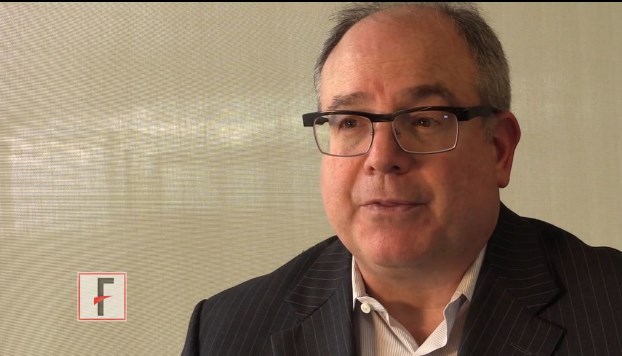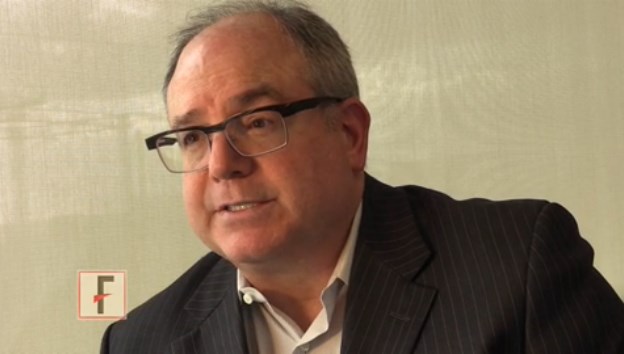User login
VIDEO: What really goes into getting new technologies paid for?
BOSTON – The real challenge for a new technology is not the good idea. It comes after FDA approval when a company must figure out how to get its device or procedure paid for, said Dr. Steven Schwaitzberg, professor and chief of the department of surgery at the University of Buffalo, speaking at the AGA Tech Summit, sponsored by the AGA Center for GI Innovation and Technology. Physicians want to provide cutting-edge tools to their patients, but they need to be reimbursed, and getting payers, like hospitals or government payers, to pay for the new procedure or device is the challenge. The AGA center facilitates this process by running observational research device registries to collect the data that show patient need, document value, and provide proof of efficacy.
The video associated with this article is no longer available on this site. Please view all of our videos on the MDedge YouTube channel
BOSTON – The real challenge for a new technology is not the good idea. It comes after FDA approval when a company must figure out how to get its device or procedure paid for, said Dr. Steven Schwaitzberg, professor and chief of the department of surgery at the University of Buffalo, speaking at the AGA Tech Summit, sponsored by the AGA Center for GI Innovation and Technology. Physicians want to provide cutting-edge tools to their patients, but they need to be reimbursed, and getting payers, like hospitals or government payers, to pay for the new procedure or device is the challenge. The AGA center facilitates this process by running observational research device registries to collect the data that show patient need, document value, and provide proof of efficacy.
The video associated with this article is no longer available on this site. Please view all of our videos on the MDedge YouTube channel
BOSTON – The real challenge for a new technology is not the good idea. It comes after FDA approval when a company must figure out how to get its device or procedure paid for, said Dr. Steven Schwaitzberg, professor and chief of the department of surgery at the University of Buffalo, speaking at the AGA Tech Summit, sponsored by the AGA Center for GI Innovation and Technology. Physicians want to provide cutting-edge tools to their patients, but they need to be reimbursed, and getting payers, like hospitals or government payers, to pay for the new procedure or device is the challenge. The AGA center facilitates this process by running observational research device registries to collect the data that show patient need, document value, and provide proof of efficacy.
The video associated with this article is no longer available on this site. Please view all of our videos on the MDedge YouTube channel
2016 AGA TECH SUMMIT
Gastroenterology is fertile ground for personalized medicine
BOSTON – The time is ripe for gastroenterologists to embrace personalized medicine, a leader in the genomics industry said at the 2016 AGA Tech Summit, which is sponsored by the AGA Center for GI Innovation and Technology.
Personalized medicine has made the most inroads in oncology, but there are compelling reasons for GI experts to get involved as well, said Mara Aspinall, executive chair of the computational genomics company GenePeeks, and president and CEO of Health Catalysts, a firm dedicated to the growth of new healthcare companies.
Virtually all aspects of gastroenterology today are emerging as fertile ground for genomic stratification of patients, Ms. Aspinall said. Inflammatory bowel disease is the first area where there already has been much work done on genomic polymorphism and how differences between patients’ disease progression can be explained, she said, and drug dosing is the first “low hanging fruit” in the area.
In addition, new areas of research can be viewed as opportunities for GI, Ms. Aspinall said. One example is the microbiome: “That’s a cutting-edge area where GI specialists can look to understand the current learning and translate them into the unique impact on their patients.” Another area is the increasingly important role of nutrition in managing patients with everything from metabolic disease to cancer. Nutritional analysis and advice has traditionally been delegated to dietitians more than gastroenterologists, but Ms. Aspinall said she believes personalized medicine in its broadest form will take the shape of using food as drugs, which puts it in GI’s wheelhouse.
Furthermore, there is much more work to be done on the gastrointestinal causes and consequences of immunological diseases, which have been understudied and underdeveloped, she said, looking in particular at patient populations at risk: children, whose immune systems and GI tracts are closely related; and women, who account for the vast majority of immune disorders such as allergies, multiple sclerosis, or lupus. “What role can the GI doc play in better diagnosis and treatment?” Ms. Aspinall said.
Over the past 50 years, the history of medicine has really been a story of diagnostics emergence, Ms. Aspinall said, including the growth of imaging, MRI, PET scans, molecular technologies, and sequencing. “We look at diagnostics as the bridge between theory and therapy,” she said.
“The headlines have been all about the new drugs and new procedures,” she said. “While that’s important, I would argue that it’s not as important as the change in diagnostics. A patient has nothing without an accurate and timely diagnosis.”
Ms. Aspinall said she sees a wider role for the field: “We need to define gastroenterology in a broader context in order to capture personalized medicine.” GI experts should start collecting data on patients’ outcomes, family histories, and complication rates as a start, she said, to look for patterns that could inform improved treatment regimens – particularly in light of genomic differences in those patients. “The reality is you’re probably not helping today’s patients but you will help patients 5 years from now,” she said.
“Cancer treatment today is organ-based,” said Ms. Aspinall. She predicted that in the not-too-distant future, cancer treatment will move more toward pathway-based treatments, as treatment is guided more and more by genetic polymorphisms.
The plummeting cost of genome sequencing is a key development that holds great promise for gastrointestinal cancers, said Raju Kucherlapati, Ph.D., who also spoke about personalized medicine in gastrointestinal cancers. Dr. Kucherlapati, a professor of genetics at Harvard Medical School and the Brigham and Women’s Hospital, Boston, said that sequencing tumor DNA is leading to risk stratification and targeted therapy in ever-increasing numbers of cancer types.
It turns out that many gastrointestinal cancers have mutations that are shared by other cancers, meaning that already-approved therapies may work for some patients with GI cancers, said Dr. Kucherlapati. For example, about 4% of colorectal cancers have amplifications of the ERBB2 gene, meaning that these patients could benefit from trastuzumab (Herceptin). “One of the aspects that’s remarkable is that drugs are already available for many of these targets, reducing the costs and time tremendously,” said Dr. Kucherlapati.
Where will this lead? The nomenclature of cancer is changing to the point where patients and their physicians in the future won’t say they have colon cancer or lung cancer but instead talk of EGFR cancer or c-KIT mutation cancer, Ms. Aspinall said: “If that happens in cancer, I am confident that it will be relevant to other specialties as well.”
In the panel discussion following the morning’s presentations, Dr. Michael Camilleri, AGA president and professor of medicine at Mayo Medical School, Rochester, Minn., agreed that a focus on personalized medicine makes sense in the GI space. “I love the idea that we need to focus on one or two big ideas,” and linking genotype to patient phenotype to target therapy should be one of them.
Ms. Aspinall and Dr. Kucherlapati reported no relevant financial disclosures.
BOSTON – The time is ripe for gastroenterologists to embrace personalized medicine, a leader in the genomics industry said at the 2016 AGA Tech Summit, which is sponsored by the AGA Center for GI Innovation and Technology.
Personalized medicine has made the most inroads in oncology, but there are compelling reasons for GI experts to get involved as well, said Mara Aspinall, executive chair of the computational genomics company GenePeeks, and president and CEO of Health Catalysts, a firm dedicated to the growth of new healthcare companies.
Virtually all aspects of gastroenterology today are emerging as fertile ground for genomic stratification of patients, Ms. Aspinall said. Inflammatory bowel disease is the first area where there already has been much work done on genomic polymorphism and how differences between patients’ disease progression can be explained, she said, and drug dosing is the first “low hanging fruit” in the area.
In addition, new areas of research can be viewed as opportunities for GI, Ms. Aspinall said. One example is the microbiome: “That’s a cutting-edge area where GI specialists can look to understand the current learning and translate them into the unique impact on their patients.” Another area is the increasingly important role of nutrition in managing patients with everything from metabolic disease to cancer. Nutritional analysis and advice has traditionally been delegated to dietitians more than gastroenterologists, but Ms. Aspinall said she believes personalized medicine in its broadest form will take the shape of using food as drugs, which puts it in GI’s wheelhouse.
Furthermore, there is much more work to be done on the gastrointestinal causes and consequences of immunological diseases, which have been understudied and underdeveloped, she said, looking in particular at patient populations at risk: children, whose immune systems and GI tracts are closely related; and women, who account for the vast majority of immune disorders such as allergies, multiple sclerosis, or lupus. “What role can the GI doc play in better diagnosis and treatment?” Ms. Aspinall said.
Over the past 50 years, the history of medicine has really been a story of diagnostics emergence, Ms. Aspinall said, including the growth of imaging, MRI, PET scans, molecular technologies, and sequencing. “We look at diagnostics as the bridge between theory and therapy,” she said.
“The headlines have been all about the new drugs and new procedures,” she said. “While that’s important, I would argue that it’s not as important as the change in diagnostics. A patient has nothing without an accurate and timely diagnosis.”
Ms. Aspinall said she sees a wider role for the field: “We need to define gastroenterology in a broader context in order to capture personalized medicine.” GI experts should start collecting data on patients’ outcomes, family histories, and complication rates as a start, she said, to look for patterns that could inform improved treatment regimens – particularly in light of genomic differences in those patients. “The reality is you’re probably not helping today’s patients but you will help patients 5 years from now,” she said.
“Cancer treatment today is organ-based,” said Ms. Aspinall. She predicted that in the not-too-distant future, cancer treatment will move more toward pathway-based treatments, as treatment is guided more and more by genetic polymorphisms.
The plummeting cost of genome sequencing is a key development that holds great promise for gastrointestinal cancers, said Raju Kucherlapati, Ph.D., who also spoke about personalized medicine in gastrointestinal cancers. Dr. Kucherlapati, a professor of genetics at Harvard Medical School and the Brigham and Women’s Hospital, Boston, said that sequencing tumor DNA is leading to risk stratification and targeted therapy in ever-increasing numbers of cancer types.
It turns out that many gastrointestinal cancers have mutations that are shared by other cancers, meaning that already-approved therapies may work for some patients with GI cancers, said Dr. Kucherlapati. For example, about 4% of colorectal cancers have amplifications of the ERBB2 gene, meaning that these patients could benefit from trastuzumab (Herceptin). “One of the aspects that’s remarkable is that drugs are already available for many of these targets, reducing the costs and time tremendously,” said Dr. Kucherlapati.
Where will this lead? The nomenclature of cancer is changing to the point where patients and their physicians in the future won’t say they have colon cancer or lung cancer but instead talk of EGFR cancer or c-KIT mutation cancer, Ms. Aspinall said: “If that happens in cancer, I am confident that it will be relevant to other specialties as well.”
In the panel discussion following the morning’s presentations, Dr. Michael Camilleri, AGA president and professor of medicine at Mayo Medical School, Rochester, Minn., agreed that a focus on personalized medicine makes sense in the GI space. “I love the idea that we need to focus on one or two big ideas,” and linking genotype to patient phenotype to target therapy should be one of them.
Ms. Aspinall and Dr. Kucherlapati reported no relevant financial disclosures.
BOSTON – The time is ripe for gastroenterologists to embrace personalized medicine, a leader in the genomics industry said at the 2016 AGA Tech Summit, which is sponsored by the AGA Center for GI Innovation and Technology.
Personalized medicine has made the most inroads in oncology, but there are compelling reasons for GI experts to get involved as well, said Mara Aspinall, executive chair of the computational genomics company GenePeeks, and president and CEO of Health Catalysts, a firm dedicated to the growth of new healthcare companies.
Virtually all aspects of gastroenterology today are emerging as fertile ground for genomic stratification of patients, Ms. Aspinall said. Inflammatory bowel disease is the first area where there already has been much work done on genomic polymorphism and how differences between patients’ disease progression can be explained, she said, and drug dosing is the first “low hanging fruit” in the area.
In addition, new areas of research can be viewed as opportunities for GI, Ms. Aspinall said. One example is the microbiome: “That’s a cutting-edge area where GI specialists can look to understand the current learning and translate them into the unique impact on their patients.” Another area is the increasingly important role of nutrition in managing patients with everything from metabolic disease to cancer. Nutritional analysis and advice has traditionally been delegated to dietitians more than gastroenterologists, but Ms. Aspinall said she believes personalized medicine in its broadest form will take the shape of using food as drugs, which puts it in GI’s wheelhouse.
Furthermore, there is much more work to be done on the gastrointestinal causes and consequences of immunological diseases, which have been understudied and underdeveloped, she said, looking in particular at patient populations at risk: children, whose immune systems and GI tracts are closely related; and women, who account for the vast majority of immune disorders such as allergies, multiple sclerosis, or lupus. “What role can the GI doc play in better diagnosis and treatment?” Ms. Aspinall said.
Over the past 50 years, the history of medicine has really been a story of diagnostics emergence, Ms. Aspinall said, including the growth of imaging, MRI, PET scans, molecular technologies, and sequencing. “We look at diagnostics as the bridge between theory and therapy,” she said.
“The headlines have been all about the new drugs and new procedures,” she said. “While that’s important, I would argue that it’s not as important as the change in diagnostics. A patient has nothing without an accurate and timely diagnosis.”
Ms. Aspinall said she sees a wider role for the field: “We need to define gastroenterology in a broader context in order to capture personalized medicine.” GI experts should start collecting data on patients’ outcomes, family histories, and complication rates as a start, she said, to look for patterns that could inform improved treatment regimens – particularly in light of genomic differences in those patients. “The reality is you’re probably not helping today’s patients but you will help patients 5 years from now,” she said.
“Cancer treatment today is organ-based,” said Ms. Aspinall. She predicted that in the not-too-distant future, cancer treatment will move more toward pathway-based treatments, as treatment is guided more and more by genetic polymorphisms.
The plummeting cost of genome sequencing is a key development that holds great promise for gastrointestinal cancers, said Raju Kucherlapati, Ph.D., who also spoke about personalized medicine in gastrointestinal cancers. Dr. Kucherlapati, a professor of genetics at Harvard Medical School and the Brigham and Women’s Hospital, Boston, said that sequencing tumor DNA is leading to risk stratification and targeted therapy in ever-increasing numbers of cancer types.
It turns out that many gastrointestinal cancers have mutations that are shared by other cancers, meaning that already-approved therapies may work for some patients with GI cancers, said Dr. Kucherlapati. For example, about 4% of colorectal cancers have amplifications of the ERBB2 gene, meaning that these patients could benefit from trastuzumab (Herceptin). “One of the aspects that’s remarkable is that drugs are already available for many of these targets, reducing the costs and time tremendously,” said Dr. Kucherlapati.
Where will this lead? The nomenclature of cancer is changing to the point where patients and their physicians in the future won’t say they have colon cancer or lung cancer but instead talk of EGFR cancer or c-KIT mutation cancer, Ms. Aspinall said: “If that happens in cancer, I am confident that it will be relevant to other specialties as well.”
In the panel discussion following the morning’s presentations, Dr. Michael Camilleri, AGA president and professor of medicine at Mayo Medical School, Rochester, Minn., agreed that a focus on personalized medicine makes sense in the GI space. “I love the idea that we need to focus on one or two big ideas,” and linking genotype to patient phenotype to target therapy should be one of them.
Ms. Aspinall and Dr. Kucherlapati reported no relevant financial disclosures.
AT THE 2016 AGA TECH SUMMIT
VIDEO: Dr. Tim Wang’s AGA Institute presidency will focus on innovation
BOSTON – Innovation, incoming AGA Institute President Timothy Wang explained at the AGA Tech Summit, is how AGA members will improve patient care and move the specialty forward. The AGA supports innovation through the work of the Center for GI Innovation and Technology, which sponsored the 2016 AGA Tech Summit, and by providing grants to young researchers through the AGA Research Foundation, such as the AGA–Boston Scientific and AGA–Covidien innovation awards, as well as many others.
The video associated with this article is no longer available on this site. Please view all of our videos on the MDedge YouTube channel
BOSTON – Innovation, incoming AGA Institute President Timothy Wang explained at the AGA Tech Summit, is how AGA members will improve patient care and move the specialty forward. The AGA supports innovation through the work of the Center for GI Innovation and Technology, which sponsored the 2016 AGA Tech Summit, and by providing grants to young researchers through the AGA Research Foundation, such as the AGA–Boston Scientific and AGA–Covidien innovation awards, as well as many others.
The video associated with this article is no longer available on this site. Please view all of our videos on the MDedge YouTube channel
BOSTON – Innovation, incoming AGA Institute President Timothy Wang explained at the AGA Tech Summit, is how AGA members will improve patient care and move the specialty forward. The AGA supports innovation through the work of the Center for GI Innovation and Technology, which sponsored the 2016 AGA Tech Summit, and by providing grants to young researchers through the AGA Research Foundation, such as the AGA–Boston Scientific and AGA–Covidien innovation awards, as well as many others.
The video associated with this article is no longer available on this site. Please view all of our videos on the MDedge YouTube channel
AT THE AGA 2016 TECH SUMMIT
Top medtech successes in gastroenterology and metabolic diseases this year
BOSTON – Gastroenterology as a specialty is in transition when it comes to technology, and gastroenterologists will have to decide whether to stay the course, performing procedures like endoscopies and colonoscopies, or also embrace additional technologies, a GI tech expert said at the 2016 AGA Tech Summit, which is sponsored by the AGA Center for GI Innovation and Technology.
“We have the ability to seize the moment and transform the specialty into a major player in therapeutics that go beyond the gut to include conditions like diabetes, obesity, or other areas,” said Dr. Pankaj Jay Pasricha, past chair of the AGA Center for GI Innovation and Technology and director of the Johns Hopkins Center for Neurogastroenterology and Johns Hopkins division of digestive diseases in Baltimore. “It’s up to us.”
Last year saw the approval of an array of devices in areas involving new endoscopic platforms, new tools for mucosal resection, and new strategies for improving the utility of endoscopic ultrasound, Dr. Pasricha said. To be employed appropriately, many of these devices will require GI professionals to seek additional training. One example includes the use of new minimally invasive balloon technologies to control obesity. Two, the Orbera Intragastric Balloon System (Apollo Endosurgery) and the ReShape Integrated Dual Balloon System (ReShape Medical) were singled out as examples.
“It’s not just simply a matter of dropping the balloon in and hoping for the best,” he said. “This requires careful training. The balloon is not an end to itself; it’s a tool for helping patients get to their goals. GIs either need to jump into this and say, ‘Yes, we want to expand’ or potentially lose business to bariatric surgeons. We will be pushed as a specialty to figure out how we want to deal with this.”
The American Gastroenterological Association has been working on this issue and is developing, in conjunction with the Society of American Gastrointestinal and Endoscopic Surgeons, The Obesity Society, and the North American Society for Pediatric Gastroenterology, Hepatology and Nutrition, a program to guide gastroenterologists who want to develop comprehensive care management programs to treat obesity with a multimodal approach. The initiative, called “POWER: Practice Guide on Obesity and Weight Management, Education and Resources,” will be available later this year, along with a white paper and bundled payment model.
Overall, 2015 was a good year for GI technologies, although not as exciting as 2014, Dr. Pasricha said. Devices approved by the Food and Drug Administration last year included the Gastric-Emptying Breath Test (Advanced Breath Diagnostics), a breath test to aid in the diagnosis of delayed gastric emptying; the Splash M-Knife (Pentax Medical), a tool to achieve complete endoscopic submucosal dissection; the Eclipse System (Pelvalon), an appliance inserted into the vagina to treat fecal incontinence in women; and Ab Stats (GI Logic), a connected wearable stethoscope to monitor the digestive system after patients have surgery. Neuromodulation for inflammatory bowel disease and irritable bowel syndrome also is an emerging area for technology, he said.
In the field of endoscopy, Dr. Pasricha noted the ever-greater emphasis being placed by the manufacturers of endoscopes on tools for therapeutics.
“It has taken a long time for endoscope companies to recognize that they need to be players not just in providing the eyes but also the hands and the tools to address the pathology that we see in procedures,” Dr. Pasricha said.
In other news from 2015, outbreaks of carbapenem-resistant Enterobacteriaceae linked to patients undergoing procedures with duodenoscopes highlighted the need to move from risk reduction to risk elimination, Dr. Pasricha said. The AGA Center for GI Innovation and Technology worked closely with the FDA to ensure GIs had the guidance and resources they needed to eliminate the risk of patient infection from duodenoscopes. Following discussions with the AGA center leadership and other invested stakeholders, the FDA in October issued new guidelines to health care facilities for cleaning the devices and ordered the devices’ three manufacturers to conduct postmarket surveillance studies to better understand how the devices are reprocessed. Additional communications from the agency regarding this postmarket surveillance are likely forthcoming.
In a similar risk-elimination case, the FDA in March halted enrollment in a clinical trial of GI Dynamics’ EndoBarrier weight loss device after a few patients developed liver infections.
The AGA and its Center for GI Innovation and Technology recognizes that training is critical to the adoption of new technologies. The center is working to develop competency thresholds for new technologies and is developing an action plan to educate the next generation of interventionalists, Dr. Pasricha said: “We need to teach gastroenterologists how to do more skilled procedures than just diagnostic endoscopy or point and shoot procedures. We also need to teach surgeons how to be facile with flexible endoscopy.”
On the reimbursement front, the AGA center – working with the other GI societies – works to put together rational reimbursement codes to reflect the new reality of the complexities of interventional procedures, he said.
“We have learned that you should not even be getting involved in commercial development of new devices without first running it through the filter of economics,” Dr. Pasricha said. A good idea for a new technology by itself is not sufficient, “especially now with all the cost constraints.”
Dr. Pasricha is a consultant, advisor, or cofounder for Apollo Endosurgery, Pentax, EndoGastric Solutions, Crospon, GI Cryo, Glyscend, Enterastim, and GI Scientific.
Ted Bosworth contributed to this report.
BOSTON – Gastroenterology as a specialty is in transition when it comes to technology, and gastroenterologists will have to decide whether to stay the course, performing procedures like endoscopies and colonoscopies, or also embrace additional technologies, a GI tech expert said at the 2016 AGA Tech Summit, which is sponsored by the AGA Center for GI Innovation and Technology.
“We have the ability to seize the moment and transform the specialty into a major player in therapeutics that go beyond the gut to include conditions like diabetes, obesity, or other areas,” said Dr. Pankaj Jay Pasricha, past chair of the AGA Center for GI Innovation and Technology and director of the Johns Hopkins Center for Neurogastroenterology and Johns Hopkins division of digestive diseases in Baltimore. “It’s up to us.”
Last year saw the approval of an array of devices in areas involving new endoscopic platforms, new tools for mucosal resection, and new strategies for improving the utility of endoscopic ultrasound, Dr. Pasricha said. To be employed appropriately, many of these devices will require GI professionals to seek additional training. One example includes the use of new minimally invasive balloon technologies to control obesity. Two, the Orbera Intragastric Balloon System (Apollo Endosurgery) and the ReShape Integrated Dual Balloon System (ReShape Medical) were singled out as examples.
“It’s not just simply a matter of dropping the balloon in and hoping for the best,” he said. “This requires careful training. The balloon is not an end to itself; it’s a tool for helping patients get to their goals. GIs either need to jump into this and say, ‘Yes, we want to expand’ or potentially lose business to bariatric surgeons. We will be pushed as a specialty to figure out how we want to deal with this.”
The American Gastroenterological Association has been working on this issue and is developing, in conjunction with the Society of American Gastrointestinal and Endoscopic Surgeons, The Obesity Society, and the North American Society for Pediatric Gastroenterology, Hepatology and Nutrition, a program to guide gastroenterologists who want to develop comprehensive care management programs to treat obesity with a multimodal approach. The initiative, called “POWER: Practice Guide on Obesity and Weight Management, Education and Resources,” will be available later this year, along with a white paper and bundled payment model.
Overall, 2015 was a good year for GI technologies, although not as exciting as 2014, Dr. Pasricha said. Devices approved by the Food and Drug Administration last year included the Gastric-Emptying Breath Test (Advanced Breath Diagnostics), a breath test to aid in the diagnosis of delayed gastric emptying; the Splash M-Knife (Pentax Medical), a tool to achieve complete endoscopic submucosal dissection; the Eclipse System (Pelvalon), an appliance inserted into the vagina to treat fecal incontinence in women; and Ab Stats (GI Logic), a connected wearable stethoscope to monitor the digestive system after patients have surgery. Neuromodulation for inflammatory bowel disease and irritable bowel syndrome also is an emerging area for technology, he said.
In the field of endoscopy, Dr. Pasricha noted the ever-greater emphasis being placed by the manufacturers of endoscopes on tools for therapeutics.
“It has taken a long time for endoscope companies to recognize that they need to be players not just in providing the eyes but also the hands and the tools to address the pathology that we see in procedures,” Dr. Pasricha said.
In other news from 2015, outbreaks of carbapenem-resistant Enterobacteriaceae linked to patients undergoing procedures with duodenoscopes highlighted the need to move from risk reduction to risk elimination, Dr. Pasricha said. The AGA Center for GI Innovation and Technology worked closely with the FDA to ensure GIs had the guidance and resources they needed to eliminate the risk of patient infection from duodenoscopes. Following discussions with the AGA center leadership and other invested stakeholders, the FDA in October issued new guidelines to health care facilities for cleaning the devices and ordered the devices’ three manufacturers to conduct postmarket surveillance studies to better understand how the devices are reprocessed. Additional communications from the agency regarding this postmarket surveillance are likely forthcoming.
In a similar risk-elimination case, the FDA in March halted enrollment in a clinical trial of GI Dynamics’ EndoBarrier weight loss device after a few patients developed liver infections.
The AGA and its Center for GI Innovation and Technology recognizes that training is critical to the adoption of new technologies. The center is working to develop competency thresholds for new technologies and is developing an action plan to educate the next generation of interventionalists, Dr. Pasricha said: “We need to teach gastroenterologists how to do more skilled procedures than just diagnostic endoscopy or point and shoot procedures. We also need to teach surgeons how to be facile with flexible endoscopy.”
On the reimbursement front, the AGA center – working with the other GI societies – works to put together rational reimbursement codes to reflect the new reality of the complexities of interventional procedures, he said.
“We have learned that you should not even be getting involved in commercial development of new devices without first running it through the filter of economics,” Dr. Pasricha said. A good idea for a new technology by itself is not sufficient, “especially now with all the cost constraints.”
Dr. Pasricha is a consultant, advisor, or cofounder for Apollo Endosurgery, Pentax, EndoGastric Solutions, Crospon, GI Cryo, Glyscend, Enterastim, and GI Scientific.
Ted Bosworth contributed to this report.
BOSTON – Gastroenterology as a specialty is in transition when it comes to technology, and gastroenterologists will have to decide whether to stay the course, performing procedures like endoscopies and colonoscopies, or also embrace additional technologies, a GI tech expert said at the 2016 AGA Tech Summit, which is sponsored by the AGA Center for GI Innovation and Technology.
“We have the ability to seize the moment and transform the specialty into a major player in therapeutics that go beyond the gut to include conditions like diabetes, obesity, or other areas,” said Dr. Pankaj Jay Pasricha, past chair of the AGA Center for GI Innovation and Technology and director of the Johns Hopkins Center for Neurogastroenterology and Johns Hopkins division of digestive diseases in Baltimore. “It’s up to us.”
Last year saw the approval of an array of devices in areas involving new endoscopic platforms, new tools for mucosal resection, and new strategies for improving the utility of endoscopic ultrasound, Dr. Pasricha said. To be employed appropriately, many of these devices will require GI professionals to seek additional training. One example includes the use of new minimally invasive balloon technologies to control obesity. Two, the Orbera Intragastric Balloon System (Apollo Endosurgery) and the ReShape Integrated Dual Balloon System (ReShape Medical) were singled out as examples.
“It’s not just simply a matter of dropping the balloon in and hoping for the best,” he said. “This requires careful training. The balloon is not an end to itself; it’s a tool for helping patients get to their goals. GIs either need to jump into this and say, ‘Yes, we want to expand’ or potentially lose business to bariatric surgeons. We will be pushed as a specialty to figure out how we want to deal with this.”
The American Gastroenterological Association has been working on this issue and is developing, in conjunction with the Society of American Gastrointestinal and Endoscopic Surgeons, The Obesity Society, and the North American Society for Pediatric Gastroenterology, Hepatology and Nutrition, a program to guide gastroenterologists who want to develop comprehensive care management programs to treat obesity with a multimodal approach. The initiative, called “POWER: Practice Guide on Obesity and Weight Management, Education and Resources,” will be available later this year, along with a white paper and bundled payment model.
Overall, 2015 was a good year for GI technologies, although not as exciting as 2014, Dr. Pasricha said. Devices approved by the Food and Drug Administration last year included the Gastric-Emptying Breath Test (Advanced Breath Diagnostics), a breath test to aid in the diagnosis of delayed gastric emptying; the Splash M-Knife (Pentax Medical), a tool to achieve complete endoscopic submucosal dissection; the Eclipse System (Pelvalon), an appliance inserted into the vagina to treat fecal incontinence in women; and Ab Stats (GI Logic), a connected wearable stethoscope to monitor the digestive system after patients have surgery. Neuromodulation for inflammatory bowel disease and irritable bowel syndrome also is an emerging area for technology, he said.
In the field of endoscopy, Dr. Pasricha noted the ever-greater emphasis being placed by the manufacturers of endoscopes on tools for therapeutics.
“It has taken a long time for endoscope companies to recognize that they need to be players not just in providing the eyes but also the hands and the tools to address the pathology that we see in procedures,” Dr. Pasricha said.
In other news from 2015, outbreaks of carbapenem-resistant Enterobacteriaceae linked to patients undergoing procedures with duodenoscopes highlighted the need to move from risk reduction to risk elimination, Dr. Pasricha said. The AGA Center for GI Innovation and Technology worked closely with the FDA to ensure GIs had the guidance and resources they needed to eliminate the risk of patient infection from duodenoscopes. Following discussions with the AGA center leadership and other invested stakeholders, the FDA in October issued new guidelines to health care facilities for cleaning the devices and ordered the devices’ three manufacturers to conduct postmarket surveillance studies to better understand how the devices are reprocessed. Additional communications from the agency regarding this postmarket surveillance are likely forthcoming.
In a similar risk-elimination case, the FDA in March halted enrollment in a clinical trial of GI Dynamics’ EndoBarrier weight loss device after a few patients developed liver infections.
The AGA and its Center for GI Innovation and Technology recognizes that training is critical to the adoption of new technologies. The center is working to develop competency thresholds for new technologies and is developing an action plan to educate the next generation of interventionalists, Dr. Pasricha said: “We need to teach gastroenterologists how to do more skilled procedures than just diagnostic endoscopy or point and shoot procedures. We also need to teach surgeons how to be facile with flexible endoscopy.”
On the reimbursement front, the AGA center – working with the other GI societies – works to put together rational reimbursement codes to reflect the new reality of the complexities of interventional procedures, he said.
“We have learned that you should not even be getting involved in commercial development of new devices without first running it through the filter of economics,” Dr. Pasricha said. A good idea for a new technology by itself is not sufficient, “especially now with all the cost constraints.”
Dr. Pasricha is a consultant, advisor, or cofounder for Apollo Endosurgery, Pentax, EndoGastric Solutions, Crospon, GI Cryo, Glyscend, Enterastim, and GI Scientific.
Ted Bosworth contributed to this report.
AT THE AGA 2016 TECH SUMMIT
Endoscopic techniques provide organ-sparing options for myotomy, resection, and more
Minimally invasive endoscopic procedures are transforming gastrointestinal surgery by offering organ-sparing approaches for a range of pathologies. At the 2016 AGA Tech Summit, Dr. David Rattner updated attendees on three of these techniques – endoscopic submucosal dissection (ESD), peroral endoscopic myotomy (POEM), and endoscopic full-thickness resection (EFTR).
“It is likely that endoluminal treatments, combined with better understanding of molecular pathology, will decrease the need for radical surgical procedures for some common gastrointestinal conditions,” he said in an interview before the meeting, which is sponsored by the AGA Center for GI Innovation and Technology. Dr. Rattner is chief of the division of gastrointestinal and general surgery at Massachusetts General Hospital in Boston.
Dr. Jose Martinez put transorifice surgery in historical perspective and pointed the way forward in an accompanying presentation. “The collaboration with physicians and industry has really started to come along with the natural orifice approach,” said Dr. Martinez, professor of surgery at the University of Miami Health System.
Developed in the 1980s and substantially refined in the mid-2000s, ESD pioneered the endoscopic resection of entire intramucosal tumors without the need for open surgery. In a recent meta-analysis, ESD achieved significantly higher rates of en bloc resection than endoscopic mucosal resection (EMR), with significantly lower rates of local recurrence and comparable complication rates (World J Gastroenterol. 2014;20:8282-7).
ESD involves resecting the mucosa and much of the submucosa, while conserving the muscular layer of the esophagus. In contrast, during POEM, the surgeon intentionally divides the muscular layer, while the intact mucosa provides the barrier between the mediastinum or peritoneum and the esophageal lumen. The defining feature of POEM is the creation of a submucosal tunnel to access the muscle layer for myotomy without incising the skin.
POEM has been found highly successful for treating esophageal achalasia. In fact, in a recently published series of 500 cases, the success rate was 100%, even though the cohort included elderly patients and those with sigmoid esophagus and complex treatment histories (J Am Coll Surg. 2015;221:256-64). Two months post-treatment, average Eckardt scores had decreased by an average of 5.0, and lower esophageal sphincter pressures had fallen by nearly 50%. The adverse event rate was 3%, there were no fatalities, and improvements persisted 3 years later. “Nationwide, numerous centers have incorporated this technique and gotten significant positive results,” said Dr. Martinez.
“POEM will be shown to be as effective as any other currently existing therapy for the treatment of achalasia,” emphasized Dr. Rattner. Indeed, its success has sparked investigations of submucosal tunneling for other indications, such as tumor resection and pyloromyotomy for gastroparesis (World J Gastroenterol. 2014;20:17746-55).
Another cutting-edge technique is EFTR, described as a powerful tool not only for acquiring diagnostic tissue, but also for sparing some patients from surgery. Compared with ESD, it has the potential for higher diagnostic yield of full-thickness specimens, such as in cases of nonlifting adenomas, adenomas at difficult anatomic locations, T1-carcinomas, or submucosal colorectal tumors. For years, a lack of safe techniques and devices kept EFTR from entering routine clinical practice. But intensive research on natural orifice translumenal endoscopic surgery (NOTES) has helped propel innovations such as over-the-scope clips for closing incisions, and smaller, more maneuverable, over-the-scope full-thickness resection devices. Large-scale trials of EFTR are lacking, but in a recent report of 19 consecutive colonic submucosal tumors, EFTR enabled the removal of the entire tumor with capsule intact in 18 instances (Endoscopy. 2013;45[09]:770-3). Notably, colonic wall defects could be closed endoscopically in 16 of 18 cases.
“We are still a ways away from being able to perform EFTR on a routine basis, but new technologies are under development that will make this possible,” said Dr. Rattner. Agreeing that the future of transorifice surgery is bright and growing, Dr. Martinez said, “Strictures, obstructions, bleeding, foreign bodies are now fully resolved through endoscopic approaches.”
Minimally invasive endoscopic procedures are transforming gastrointestinal surgery by offering organ-sparing approaches for a range of pathologies. At the 2016 AGA Tech Summit, Dr. David Rattner updated attendees on three of these techniques – endoscopic submucosal dissection (ESD), peroral endoscopic myotomy (POEM), and endoscopic full-thickness resection (EFTR).
“It is likely that endoluminal treatments, combined with better understanding of molecular pathology, will decrease the need for radical surgical procedures for some common gastrointestinal conditions,” he said in an interview before the meeting, which is sponsored by the AGA Center for GI Innovation and Technology. Dr. Rattner is chief of the division of gastrointestinal and general surgery at Massachusetts General Hospital in Boston.
Dr. Jose Martinez put transorifice surgery in historical perspective and pointed the way forward in an accompanying presentation. “The collaboration with physicians and industry has really started to come along with the natural orifice approach,” said Dr. Martinez, professor of surgery at the University of Miami Health System.
Developed in the 1980s and substantially refined in the mid-2000s, ESD pioneered the endoscopic resection of entire intramucosal tumors without the need for open surgery. In a recent meta-analysis, ESD achieved significantly higher rates of en bloc resection than endoscopic mucosal resection (EMR), with significantly lower rates of local recurrence and comparable complication rates (World J Gastroenterol. 2014;20:8282-7).
ESD involves resecting the mucosa and much of the submucosa, while conserving the muscular layer of the esophagus. In contrast, during POEM, the surgeon intentionally divides the muscular layer, while the intact mucosa provides the barrier between the mediastinum or peritoneum and the esophageal lumen. The defining feature of POEM is the creation of a submucosal tunnel to access the muscle layer for myotomy without incising the skin.
POEM has been found highly successful for treating esophageal achalasia. In fact, in a recently published series of 500 cases, the success rate was 100%, even though the cohort included elderly patients and those with sigmoid esophagus and complex treatment histories (J Am Coll Surg. 2015;221:256-64). Two months post-treatment, average Eckardt scores had decreased by an average of 5.0, and lower esophageal sphincter pressures had fallen by nearly 50%. The adverse event rate was 3%, there were no fatalities, and improvements persisted 3 years later. “Nationwide, numerous centers have incorporated this technique and gotten significant positive results,” said Dr. Martinez.
“POEM will be shown to be as effective as any other currently existing therapy for the treatment of achalasia,” emphasized Dr. Rattner. Indeed, its success has sparked investigations of submucosal tunneling for other indications, such as tumor resection and pyloromyotomy for gastroparesis (World J Gastroenterol. 2014;20:17746-55).
Another cutting-edge technique is EFTR, described as a powerful tool not only for acquiring diagnostic tissue, but also for sparing some patients from surgery. Compared with ESD, it has the potential for higher diagnostic yield of full-thickness specimens, such as in cases of nonlifting adenomas, adenomas at difficult anatomic locations, T1-carcinomas, or submucosal colorectal tumors. For years, a lack of safe techniques and devices kept EFTR from entering routine clinical practice. But intensive research on natural orifice translumenal endoscopic surgery (NOTES) has helped propel innovations such as over-the-scope clips for closing incisions, and smaller, more maneuverable, over-the-scope full-thickness resection devices. Large-scale trials of EFTR are lacking, but in a recent report of 19 consecutive colonic submucosal tumors, EFTR enabled the removal of the entire tumor with capsule intact in 18 instances (Endoscopy. 2013;45[09]:770-3). Notably, colonic wall defects could be closed endoscopically in 16 of 18 cases.
“We are still a ways away from being able to perform EFTR on a routine basis, but new technologies are under development that will make this possible,” said Dr. Rattner. Agreeing that the future of transorifice surgery is bright and growing, Dr. Martinez said, “Strictures, obstructions, bleeding, foreign bodies are now fully resolved through endoscopic approaches.”
Minimally invasive endoscopic procedures are transforming gastrointestinal surgery by offering organ-sparing approaches for a range of pathologies. At the 2016 AGA Tech Summit, Dr. David Rattner updated attendees on three of these techniques – endoscopic submucosal dissection (ESD), peroral endoscopic myotomy (POEM), and endoscopic full-thickness resection (EFTR).
“It is likely that endoluminal treatments, combined with better understanding of molecular pathology, will decrease the need for radical surgical procedures for some common gastrointestinal conditions,” he said in an interview before the meeting, which is sponsored by the AGA Center for GI Innovation and Technology. Dr. Rattner is chief of the division of gastrointestinal and general surgery at Massachusetts General Hospital in Boston.
Dr. Jose Martinez put transorifice surgery in historical perspective and pointed the way forward in an accompanying presentation. “The collaboration with physicians and industry has really started to come along with the natural orifice approach,” said Dr. Martinez, professor of surgery at the University of Miami Health System.
Developed in the 1980s and substantially refined in the mid-2000s, ESD pioneered the endoscopic resection of entire intramucosal tumors without the need for open surgery. In a recent meta-analysis, ESD achieved significantly higher rates of en bloc resection than endoscopic mucosal resection (EMR), with significantly lower rates of local recurrence and comparable complication rates (World J Gastroenterol. 2014;20:8282-7).
ESD involves resecting the mucosa and much of the submucosa, while conserving the muscular layer of the esophagus. In contrast, during POEM, the surgeon intentionally divides the muscular layer, while the intact mucosa provides the barrier between the mediastinum or peritoneum and the esophageal lumen. The defining feature of POEM is the creation of a submucosal tunnel to access the muscle layer for myotomy without incising the skin.
POEM has been found highly successful for treating esophageal achalasia. In fact, in a recently published series of 500 cases, the success rate was 100%, even though the cohort included elderly patients and those with sigmoid esophagus and complex treatment histories (J Am Coll Surg. 2015;221:256-64). Two months post-treatment, average Eckardt scores had decreased by an average of 5.0, and lower esophageal sphincter pressures had fallen by nearly 50%. The adverse event rate was 3%, there were no fatalities, and improvements persisted 3 years later. “Nationwide, numerous centers have incorporated this technique and gotten significant positive results,” said Dr. Martinez.
“POEM will be shown to be as effective as any other currently existing therapy for the treatment of achalasia,” emphasized Dr. Rattner. Indeed, its success has sparked investigations of submucosal tunneling for other indications, such as tumor resection and pyloromyotomy for gastroparesis (World J Gastroenterol. 2014;20:17746-55).
Another cutting-edge technique is EFTR, described as a powerful tool not only for acquiring diagnostic tissue, but also for sparing some patients from surgery. Compared with ESD, it has the potential for higher diagnostic yield of full-thickness specimens, such as in cases of nonlifting adenomas, adenomas at difficult anatomic locations, T1-carcinomas, or submucosal colorectal tumors. For years, a lack of safe techniques and devices kept EFTR from entering routine clinical practice. But intensive research on natural orifice translumenal endoscopic surgery (NOTES) has helped propel innovations such as over-the-scope clips for closing incisions, and smaller, more maneuverable, over-the-scope full-thickness resection devices. Large-scale trials of EFTR are lacking, but in a recent report of 19 consecutive colonic submucosal tumors, EFTR enabled the removal of the entire tumor with capsule intact in 18 instances (Endoscopy. 2013;45[09]:770-3). Notably, colonic wall defects could be closed endoscopically in 16 of 18 cases.
“We are still a ways away from being able to perform EFTR on a routine basis, but new technologies are under development that will make this possible,” said Dr. Rattner. Agreeing that the future of transorifice surgery is bright and growing, Dr. Martinez said, “Strictures, obstructions, bleeding, foreign bodies are now fully resolved through endoscopic approaches.”
AT THE 2016 AGA TECH SUMMIT
IBD: Chronic, not ‘crisis’ care
BOSTON – Inflammatory bowel disease (IBD) has gone from being a condition largely managed on a crisis basis to one in which the goal is to prevent acute exacerbations and preserve a low level of disease activity over its chronic course.
While this model saves costs and creates better patient outcomes overall, it requires specialists to approach care differently, including leveraging an ever-widening array of clinical innovations.
“The chronic disease management model requires regular monitoring and advanced technologies to better characterize the disease activity and response to therapy,” said Dr. David Rubin, section chief of gastroenterology, hepatology, and nutrition at the University of Chicago. In addition to keeping chronic disease from drifting away from stability, Dr. Rubin said, “Effective monitoring should allow proactive management decisions and ongoing control and changing disease natural history.”
The challenge has been to identify tools useful in monitoring patients with IBD to ensure that disease is under control, according to a panel of speakers addressing this topic at the 2016 AGA Tech Summit, which is sponsored by the AGA Center for GI Innovation and Technology. The relationship of inflammation in the bowel to symptoms is notoriously poor, including both a high degree of disease activity in those with relatively few symptoms and a low degree of inflammation in those seeking care because of a poor quality of life.
“We need better and less invasive ways to monitor disease control as well as better predictors of risk of exacerbations,” Dr. Rubin said. Although a variety of biomarkers are already used to evaluate IBD, such as C-reactive protein and fecal calprotectin levels, none is fully reliable as an isolated measure, according to Dr. Rubin. Ongoing studies are pursuing biomarkers measured in the urine, from the breath, and by genetic analysis, but the key to each is demonstrating that changing management on the basis of the information they provide results in better long-term outcomes.
Currently, endoscopy is the most reliable tool for evaluating disease activity and guiding therapeutic decisions, according to Dr. Edward V. Loftus, professor of medicine at the Mayo Clinic, Rochester, Minn., and a session copanelist with Dr. Rubin. Although several scoring systems are employed to reduce subjectivity in endoscopic evaluation of disease activity, Dr. Loftus suggested that no scoring system eliminates interobserver variability.
At least for clinical trials, employing central reading of endoscopic studies has been one approach to reduce interobserver variability and to “drive down placebo rates” that are typically substantial in drug trial studies. Not least important among endoscopic measures is the confirmation of mucosal healing.
“Mucosal healing is a binary concept. It is either complete or it is not,” explained Dr. Loftus, citing several studies suggesting that the risk of disease relapse is lower when mucosal healing is achieved. Endoscopy is currently the only reliable method of establishing mucosal healing. However, he said that precise measurement of disease activity “takes a little bit of training,” a problem that represents “an unmet need” for more efficient disease evaluation.
“One could envision somebody designing software built into the scope that will automatically score the degree of IBD severity.” Dr. Loftus said. “These tools have already resulted in a change in the types of clinical trial endpoints used, and one could argue that they are more objective now.”
The need for better tools for prognosis will only increase as treatments for IBD continue to expand, according to Dr. Gary R. Lichtenstein, professor of medicine at the University of Pennsylvania, Philadelphia. He emphasized that there is wide variability in response even to the most effective treatments. Tools useful for quickly evaluating when a therapy is or is not working would be extremely useful for switching patients to an alternative drug.
These alternative drugs include an expanding array of mechanisms of action with more reaching late stages of clinical testing, according to Dr. Lichtenstein, who reviewed the mechanism of integrin inhibitors, small-molecule therapies targeting the JAK pathway, and cytokine inhibitors. There are also strategies being pursued that involve manipulating the microbiome to control IBD.
“The therapies we have currently are totally inadequate,” said Dr. Lichtenstein, underscoring the excitement about clinical activity observed with drugs that offer novel mechanisms of action.
The activity in this field is being closely monitored by the AGA’s Center for Diagnostics and Therapeutics (CDT), which is chaired by Dr. Colin. W. Howden, gastroenterology chief at the University of Tennessee Health Science Center, Memphis. Although the interests of the CDT, which met last summer with the U.S. Food and Drug Administration to discuss issues of mutual interest in GI therapeutics, is not limited to IBD, this set of diseases was a focus in its first stand-alone conference held in October 2015. According to Dr. Howden, the discussion at that meeting provided the framework for the program at the 2016 AGA Tech Summit.
On Twitter @whitneymcknight
BOSTON – Inflammatory bowel disease (IBD) has gone from being a condition largely managed on a crisis basis to one in which the goal is to prevent acute exacerbations and preserve a low level of disease activity over its chronic course.
While this model saves costs and creates better patient outcomes overall, it requires specialists to approach care differently, including leveraging an ever-widening array of clinical innovations.
“The chronic disease management model requires regular monitoring and advanced technologies to better characterize the disease activity and response to therapy,” said Dr. David Rubin, section chief of gastroenterology, hepatology, and nutrition at the University of Chicago. In addition to keeping chronic disease from drifting away from stability, Dr. Rubin said, “Effective monitoring should allow proactive management decisions and ongoing control and changing disease natural history.”
The challenge has been to identify tools useful in monitoring patients with IBD to ensure that disease is under control, according to a panel of speakers addressing this topic at the 2016 AGA Tech Summit, which is sponsored by the AGA Center for GI Innovation and Technology. The relationship of inflammation in the bowel to symptoms is notoriously poor, including both a high degree of disease activity in those with relatively few symptoms and a low degree of inflammation in those seeking care because of a poor quality of life.
“We need better and less invasive ways to monitor disease control as well as better predictors of risk of exacerbations,” Dr. Rubin said. Although a variety of biomarkers are already used to evaluate IBD, such as C-reactive protein and fecal calprotectin levels, none is fully reliable as an isolated measure, according to Dr. Rubin. Ongoing studies are pursuing biomarkers measured in the urine, from the breath, and by genetic analysis, but the key to each is demonstrating that changing management on the basis of the information they provide results in better long-term outcomes.
Currently, endoscopy is the most reliable tool for evaluating disease activity and guiding therapeutic decisions, according to Dr. Edward V. Loftus, professor of medicine at the Mayo Clinic, Rochester, Minn., and a session copanelist with Dr. Rubin. Although several scoring systems are employed to reduce subjectivity in endoscopic evaluation of disease activity, Dr. Loftus suggested that no scoring system eliminates interobserver variability.
At least for clinical trials, employing central reading of endoscopic studies has been one approach to reduce interobserver variability and to “drive down placebo rates” that are typically substantial in drug trial studies. Not least important among endoscopic measures is the confirmation of mucosal healing.
“Mucosal healing is a binary concept. It is either complete or it is not,” explained Dr. Loftus, citing several studies suggesting that the risk of disease relapse is lower when mucosal healing is achieved. Endoscopy is currently the only reliable method of establishing mucosal healing. However, he said that precise measurement of disease activity “takes a little bit of training,” a problem that represents “an unmet need” for more efficient disease evaluation.
“One could envision somebody designing software built into the scope that will automatically score the degree of IBD severity.” Dr. Loftus said. “These tools have already resulted in a change in the types of clinical trial endpoints used, and one could argue that they are more objective now.”
The need for better tools for prognosis will only increase as treatments for IBD continue to expand, according to Dr. Gary R. Lichtenstein, professor of medicine at the University of Pennsylvania, Philadelphia. He emphasized that there is wide variability in response even to the most effective treatments. Tools useful for quickly evaluating when a therapy is or is not working would be extremely useful for switching patients to an alternative drug.
These alternative drugs include an expanding array of mechanisms of action with more reaching late stages of clinical testing, according to Dr. Lichtenstein, who reviewed the mechanism of integrin inhibitors, small-molecule therapies targeting the JAK pathway, and cytokine inhibitors. There are also strategies being pursued that involve manipulating the microbiome to control IBD.
“The therapies we have currently are totally inadequate,” said Dr. Lichtenstein, underscoring the excitement about clinical activity observed with drugs that offer novel mechanisms of action.
The activity in this field is being closely monitored by the AGA’s Center for Diagnostics and Therapeutics (CDT), which is chaired by Dr. Colin. W. Howden, gastroenterology chief at the University of Tennessee Health Science Center, Memphis. Although the interests of the CDT, which met last summer with the U.S. Food and Drug Administration to discuss issues of mutual interest in GI therapeutics, is not limited to IBD, this set of diseases was a focus in its first stand-alone conference held in October 2015. According to Dr. Howden, the discussion at that meeting provided the framework for the program at the 2016 AGA Tech Summit.
On Twitter @whitneymcknight
BOSTON – Inflammatory bowel disease (IBD) has gone from being a condition largely managed on a crisis basis to one in which the goal is to prevent acute exacerbations and preserve a low level of disease activity over its chronic course.
While this model saves costs and creates better patient outcomes overall, it requires specialists to approach care differently, including leveraging an ever-widening array of clinical innovations.
“The chronic disease management model requires regular monitoring and advanced technologies to better characterize the disease activity and response to therapy,” said Dr. David Rubin, section chief of gastroenterology, hepatology, and nutrition at the University of Chicago. In addition to keeping chronic disease from drifting away from stability, Dr. Rubin said, “Effective monitoring should allow proactive management decisions and ongoing control and changing disease natural history.”
The challenge has been to identify tools useful in monitoring patients with IBD to ensure that disease is under control, according to a panel of speakers addressing this topic at the 2016 AGA Tech Summit, which is sponsored by the AGA Center for GI Innovation and Technology. The relationship of inflammation in the bowel to symptoms is notoriously poor, including both a high degree of disease activity in those with relatively few symptoms and a low degree of inflammation in those seeking care because of a poor quality of life.
“We need better and less invasive ways to monitor disease control as well as better predictors of risk of exacerbations,” Dr. Rubin said. Although a variety of biomarkers are already used to evaluate IBD, such as C-reactive protein and fecal calprotectin levels, none is fully reliable as an isolated measure, according to Dr. Rubin. Ongoing studies are pursuing biomarkers measured in the urine, from the breath, and by genetic analysis, but the key to each is demonstrating that changing management on the basis of the information they provide results in better long-term outcomes.
Currently, endoscopy is the most reliable tool for evaluating disease activity and guiding therapeutic decisions, according to Dr. Edward V. Loftus, professor of medicine at the Mayo Clinic, Rochester, Minn., and a session copanelist with Dr. Rubin. Although several scoring systems are employed to reduce subjectivity in endoscopic evaluation of disease activity, Dr. Loftus suggested that no scoring system eliminates interobserver variability.
At least for clinical trials, employing central reading of endoscopic studies has been one approach to reduce interobserver variability and to “drive down placebo rates” that are typically substantial in drug trial studies. Not least important among endoscopic measures is the confirmation of mucosal healing.
“Mucosal healing is a binary concept. It is either complete or it is not,” explained Dr. Loftus, citing several studies suggesting that the risk of disease relapse is lower when mucosal healing is achieved. Endoscopy is currently the only reliable method of establishing mucosal healing. However, he said that precise measurement of disease activity “takes a little bit of training,” a problem that represents “an unmet need” for more efficient disease evaluation.
“One could envision somebody designing software built into the scope that will automatically score the degree of IBD severity.” Dr. Loftus said. “These tools have already resulted in a change in the types of clinical trial endpoints used, and one could argue that they are more objective now.”
The need for better tools for prognosis will only increase as treatments for IBD continue to expand, according to Dr. Gary R. Lichtenstein, professor of medicine at the University of Pennsylvania, Philadelphia. He emphasized that there is wide variability in response even to the most effective treatments. Tools useful for quickly evaluating when a therapy is or is not working would be extremely useful for switching patients to an alternative drug.
These alternative drugs include an expanding array of mechanisms of action with more reaching late stages of clinical testing, according to Dr. Lichtenstein, who reviewed the mechanism of integrin inhibitors, small-molecule therapies targeting the JAK pathway, and cytokine inhibitors. There are also strategies being pursued that involve manipulating the microbiome to control IBD.
“The therapies we have currently are totally inadequate,” said Dr. Lichtenstein, underscoring the excitement about clinical activity observed with drugs that offer novel mechanisms of action.
The activity in this field is being closely monitored by the AGA’s Center for Diagnostics and Therapeutics (CDT), which is chaired by Dr. Colin. W. Howden, gastroenterology chief at the University of Tennessee Health Science Center, Memphis. Although the interests of the CDT, which met last summer with the U.S. Food and Drug Administration to discuss issues of mutual interest in GI therapeutics, is not limited to IBD, this set of diseases was a focus in its first stand-alone conference held in October 2015. According to Dr. Howden, the discussion at that meeting provided the framework for the program at the 2016 AGA Tech Summit.
On Twitter @whitneymcknight
AT THE 2016 AGA TECH SUMMIT
VIDEO: The New Gastroenterologist offers insights, lifestyle info for young specialists
PHILADELPHIA – Are there things you wish you’d learned as a gastroenterology fellow? How to build a reputation as a good speaker, how to grow a successful clinical practice, and even how to choose the best retirement fund options for your personal goals are the kinds of tips and insights you’ll find in The New Gastroenterologist.
The newest publication from the American Gastroenterological Association, The New Gastroenterologist offers practical clinical information, lifestyle features, interviews with leaders in the field, and details on where to find research funding.
“Our goal is to provide unique content that speaks to all the needs that young gastroenterologists have, and to have it all in one place,” says The New Gastroenterologist Editor-in-Chief Dr. Bryson Katona.
The video associated with this article is no longer available on this site. Please view all of our videos on the MDedge YouTube channel
On Twitter @whitneymcknight
PHILADELPHIA – Are there things you wish you’d learned as a gastroenterology fellow? How to build a reputation as a good speaker, how to grow a successful clinical practice, and even how to choose the best retirement fund options for your personal goals are the kinds of tips and insights you’ll find in The New Gastroenterologist.
The newest publication from the American Gastroenterological Association, The New Gastroenterologist offers practical clinical information, lifestyle features, interviews with leaders in the field, and details on where to find research funding.
“Our goal is to provide unique content that speaks to all the needs that young gastroenterologists have, and to have it all in one place,” says The New Gastroenterologist Editor-in-Chief Dr. Bryson Katona.
The video associated with this article is no longer available on this site. Please view all of our videos on the MDedge YouTube channel
On Twitter @whitneymcknight
PHILADELPHIA – Are there things you wish you’d learned as a gastroenterology fellow? How to build a reputation as a good speaker, how to grow a successful clinical practice, and even how to choose the best retirement fund options for your personal goals are the kinds of tips and insights you’ll find in The New Gastroenterologist.
The newest publication from the American Gastroenterological Association, The New Gastroenterologist offers practical clinical information, lifestyle features, interviews with leaders in the field, and details on where to find research funding.
“Our goal is to provide unique content that speaks to all the needs that young gastroenterologists have, and to have it all in one place,” says The New Gastroenterologist Editor-in-Chief Dr. Bryson Katona.
The video associated with this article is no longer available on this site. Please view all of our videos on the MDedge YouTube channel
On Twitter @whitneymcknight
VIDEO: It’s an exciting time in GI; Dr. Michael Kochman explains why
PHILADELPHIA – Better patient care means seeing to a patient’s overall health, according to Dr. Michael L. Kochman, chair of the American Gastroenterological Association’s Center for GI Innovation and Technology.
Dr. Kochman says that, thanks to recent innovations, different management strategies for certain diseases such as Barrett’s esophagus has meant gastroenterology has seen “rapid progress and significant change,” all of which are leading to better patient outcomes. Ablative techniques, for example, have helped reduce the number of thoracotomies performed in patients with Barrett’s.
Hear about other innovations in GI in this video. You can also visit the center’s website.
The video associated with this article is no longer available on this site. Please view all of our videos on the MDedge YouTube channel
On Twitter @whitneymcknight
PHILADELPHIA – Better patient care means seeing to a patient’s overall health, according to Dr. Michael L. Kochman, chair of the American Gastroenterological Association’s Center for GI Innovation and Technology.
Dr. Kochman says that, thanks to recent innovations, different management strategies for certain diseases such as Barrett’s esophagus has meant gastroenterology has seen “rapid progress and significant change,” all of which are leading to better patient outcomes. Ablative techniques, for example, have helped reduce the number of thoracotomies performed in patients with Barrett’s.
Hear about other innovations in GI in this video. You can also visit the center’s website.
The video associated with this article is no longer available on this site. Please view all of our videos on the MDedge YouTube channel
On Twitter @whitneymcknight
PHILADELPHIA – Better patient care means seeing to a patient’s overall health, according to Dr. Michael L. Kochman, chair of the American Gastroenterological Association’s Center for GI Innovation and Technology.
Dr. Kochman says that, thanks to recent innovations, different management strategies for certain diseases such as Barrett’s esophagus has meant gastroenterology has seen “rapid progress and significant change,” all of which are leading to better patient outcomes. Ablative techniques, for example, have helped reduce the number of thoracotomies performed in patients with Barrett’s.
Hear about other innovations in GI in this video. You can also visit the center’s website.
The video associated with this article is no longer available on this site. Please view all of our videos on the MDedge YouTube channel
On Twitter @whitneymcknight
VIDEO: Gastroenterologists seek to shape future, not react to it
PHILADELPHIA – For those who seek to shape rather than react to the future of gastroenterology, attendance at the American Gastroenterological Association annual Tech Summit is essential.
While personalized medicine is poised to revolutionize medicine across the specialties, “We have some surprises upcoming in how we can really leverage and apply [personalized medicine] in gastroenterology,” says Dr. Michael L. Kochman, AGAF, chair of the AGA Center for GI Innovation and Technology.
Among new devices that will be featured at this year’s Tech Summit will be some from the bariatric and antireflux spaces, according to Dr. Kochman.
“Our ability to influence the future, rather than react to it is critical,” he says.
To learn more visit www.techsummit.gastro.org. Look out for the AGA’s Tech Summit report with videos and articles highlighting the most interesting talks from the summit.
The video associated with this article is no longer available on this site. Please view all of our videos on the MDedge YouTube channel
On Twitter @whitneymcknight
PHILADELPHIA – For those who seek to shape rather than react to the future of gastroenterology, attendance at the American Gastroenterological Association annual Tech Summit is essential.
While personalized medicine is poised to revolutionize medicine across the specialties, “We have some surprises upcoming in how we can really leverage and apply [personalized medicine] in gastroenterology,” says Dr. Michael L. Kochman, AGAF, chair of the AGA Center for GI Innovation and Technology.
Among new devices that will be featured at this year’s Tech Summit will be some from the bariatric and antireflux spaces, according to Dr. Kochman.
“Our ability to influence the future, rather than react to it is critical,” he says.
To learn more visit www.techsummit.gastro.org. Look out for the AGA’s Tech Summit report with videos and articles highlighting the most interesting talks from the summit.
The video associated with this article is no longer available on this site. Please view all of our videos on the MDedge YouTube channel
On Twitter @whitneymcknight
PHILADELPHIA – For those who seek to shape rather than react to the future of gastroenterology, attendance at the American Gastroenterological Association annual Tech Summit is essential.
While personalized medicine is poised to revolutionize medicine across the specialties, “We have some surprises upcoming in how we can really leverage and apply [personalized medicine] in gastroenterology,” says Dr. Michael L. Kochman, AGAF, chair of the AGA Center for GI Innovation and Technology.
Among new devices that will be featured at this year’s Tech Summit will be some from the bariatric and antireflux spaces, according to Dr. Kochman.
“Our ability to influence the future, rather than react to it is critical,” he says.
To learn more visit www.techsummit.gastro.org. Look out for the AGA’s Tech Summit report with videos and articles highlighting the most interesting talks from the summit.
The video associated with this article is no longer available on this site. Please view all of our videos on the MDedge YouTube channel
On Twitter @whitneymcknight
